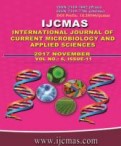


 National Academy of Agricultural Sciences (NAAS)
National Academy of Agricultural Sciences (NAAS)

|
PRINT ISSN : 2319-7692
Online ISSN : 2319-7706 Issues : 12 per year Publisher : Excellent Publishers Email : editorijcmas@gmail.com / submit@ijcmas.com Editor-in-chief: Dr.M.Prakash Index Copernicus ICV 2018: 95.39 NAAS RATING 2020: 5.38 |
The pluralistic extension service requires a central coordinating agency for its success. In India ATMA working at grass root level through bottom up approach and trying to coordinate different extension, research organizations with farming community. Information from several sources is extended, funds are effectively utilised and duplication of work is avoided for the agricultural development through ATMA. The complete procedure to measure the coordination of ATMA and the factors governing the coordination is described in this paper. The five categories of coordination as data analysed using cumulative square root frequency method (CSRF method). According to the data obtained and analysed, most of the respondents (29.85075%) represents there is a high coordination followed by medium (25.37313%) coordination and Low coordination (16.41791%). However, few respondents were represented for Very high coordination (13.43284%) as well as for Very low coordination (14.92537%) of ATMA with different agencies at the level. Form pilot cum phase one of ATMA is showing a better coordination. Factor analysis used to identify seven factors effecting coordination viz. Roles and Responsibility of agencies, organizing ability of the ATMA, Combine plan and implementation, Degree of interest of agencies, Individuals’ degree of contribution, Mutual trust in problem solving and Participation and efficiency of fund sharing among agencies. It helps extension functionaries to give emphasis on identified factors for effective performance. Further, suggests the policy makers to plan ATMA like programs still effective way.
 |
 |
 |
 |
 |